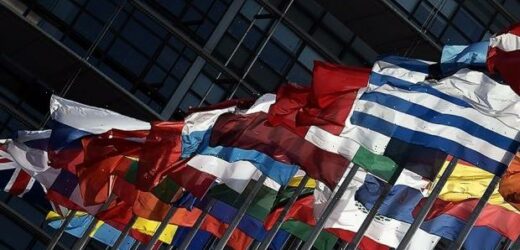UNLESS you’re a flag enthusiast or know your own country’s really well, chances are you won’t recognise what certain symbols and colours actually stand for.
From our own red, white and blue to the stars on the Chinese flag, the little symbols have more meaning than meets the eye, according to Flags Australia president Ralph Kelly…
Here are 10 flags with hidden meanings
Australia
According to Ralph, while the Australian flag has an obvious connection to Britain, that meaning has become more symbolic over time.
He said when the flag was created in 1901, the Union Jack was added to show Australia was part of the British Empire, and the blue background was common of colonial nations.
Ralph said it was now so widely ingrained in Australian’s minds but the whole connection between the flag and the monarchy is ingrained rather than intended.
Interestingly he said there had been subtle changes made over time, including the addition of seven point stars in 1908 instead of the original six which represents the states.
Germany
The European country was actually clever when its current flag was re-adopted in 1949.
The Germans wanted to go back to the flag which was adopted as a flag of modern Germany in 1919 after World War I.
When the Nazis stormed to power, the country became symbolic with red, white and black in a massive nod to Prussian heritage and Germany’s military tradition and domination.
“Germany wanted to get away from any military meaning or association,” he said.
“Red, gold and black were symbolic of the Weimar Republic and more removed from the Nazi colours and symbolism.”
South Africa
South Africa’s flag represents unity and inclusiveness to rebel against the racial segregation experienced during the apartheid
When South Africa became a democracy in 1994, calls were made to create a flag which represented unity.
While it definitely does do just that, Ralph said it was clever because it also emphasised the country’s true diversity.
While recognising its British (half Union Jack, blue red) heritage the African National Congress colours of black, green and yellow also feature prominently.
The blue white and red horizontal are also the colours of the Dutch flag.
“This hidden meaning is here because the emphasis on unity, but really the significance of this flag is in its diversity (of its people).”
Under apartheid, South Africa suffered racial segregation which was carried out under white rule introduced in 1948 by the Afrikaner-dominated National Party.
Related Articles
48 Hours in Hanoi Cool bars, hidden courtyards and history aplenty… Uncover the charm of Vietnam's budget-friendly city
The shrapnel that 'rewrote British history': Historic pictures show Churchill on the front line in WWI
From culture and history to beer and relaxation, there's more than meets the eye in peaceful Norfolk
Hillary Clinton makes American history by becoming first woman nominated by major party to be president
Brazil
While this South American country is known for being a little out there, its flag symbolism may appear a little less obvious.
The flag features 26 stars to represent its states and federal district.
But rather than line up neatly, they were placed as they would have been positioned on November 15, 1889, which was the moment several constellations were seen in the Rio sky, according to Shutterstock.
The stars are also reversed on purpose to represent the view someone would see of Rio from space.
Grenada
The flag of this Caribbean nation is another clever creation.
Red stands for strength, gold for wisdom and the seven stars its parishes, and green stands for its lush vegetation.
But the little symbol on the left may leave some scratching their heads.
According to official website of the government of Grenada, the tiny symbol is significant for one big reason.
Not only does it represent nutmeg, but it also symbolises its “reputation as the Isle of Spice”.
China
This bold flag appears to almost contradict itself in meaning
We all know red stands for power, but it’s also the colour associated with Communism and the spirit of the revolution which took place in 1949.
But perhaps less obvious at least to some, is what its five yellow stars mean.
The large star represents unity under the Communist Party, according to China Daily.
The four others represent China’s traditional classes — the working, the peasantry, the urban bourgeois, and the national bourgeois or the capitalists.
India
The Indian flag is another well-known flag and a fixture at cricket matches.
The flag was adopted in July 1947 following independence from British rule.
At the centre is the navy blue circle Ashoka Chakra which means Wheel of Law.
Not only does it represent 24 hours in the day but also acknowledges the Hindu religion.
The orange represents courage and also is significant for Hindus, Buddhists and Jains, according to India Celebrating.
The white stripe represents purity while the green represents faith and fertility with the colour also having special significance for Muslims.
Botswana
This African nation’s flag features the colours of light blue, with white stripes and a black centre.
Black and white stands for harmony and the colours also correspond to the national coat of arms.
According to the Botswana embassy, the blue represents the nation’s dependence on water while the black and white stripes are also a nod to its national symbol of the zebra.
Austria
If you don’t like a meaning – switch up. The Austrians did
This flag dates back to 1084 and has a bloody history, literally.
It is said to be inspired from a legend about Duke Leopold IV of Austria who according to legend fought in battle during the Crusades.
But during the battle he was severely injured and bloodied but despite this did not get a drop on his white clothing, according to Maps of the world.
However, today Austrians don’t associate the colours with war but rather peace.
North Korea
North Korea has the second biggest flagpole in the world
Most of us can guess the significance of red, communism/socialism and the star in the middle is also a nod to that.
The white is said to represent purity but the meaning behind the blue may appear ironic to some with these stripes said to represent peace, Famous Wonders reveal.
The colours are significant in both Koreas' flags but the North has given much more prominence to the colour red.
Interestingly, North Korea has the second largest flagpole in the world at 160m and its army, air force and navy all have modifications of this.
Source: Read Full Article
















